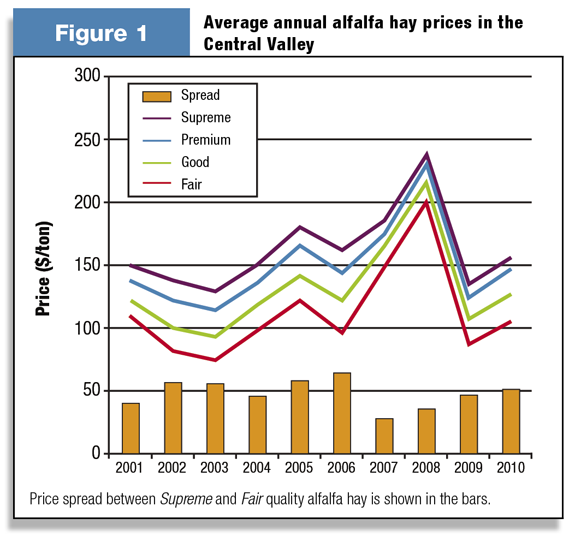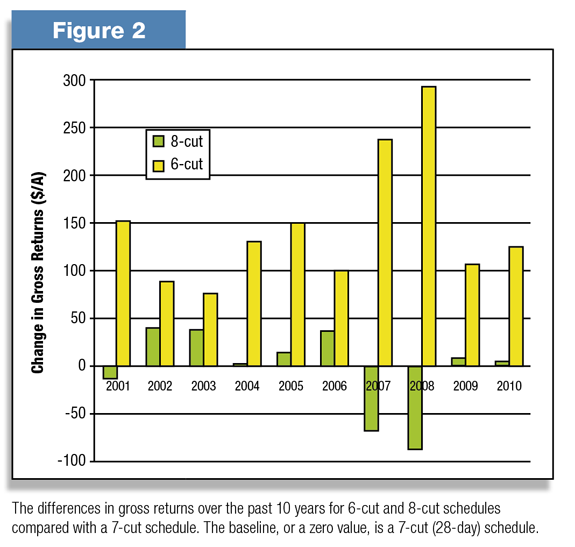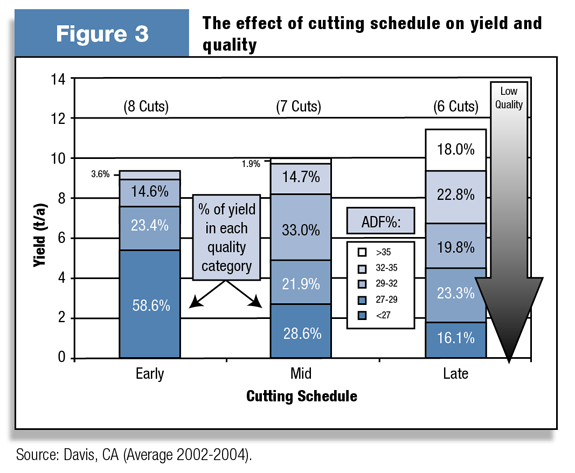The existence of a yield-quality tradeoff has been well-documented over the years in field trials and through grower experience.
Within reason, fewer cuttings per season generally result in higher yield per season but at the expense of forage quality.
However, determining the optimum cutting schedule is challenging due to ever-changing weather and price conditions.
Using University of California field research conducted in the Central Valley and the Intermountain area on cutting schedules, we used hay market data over the last 10 years to assess gross profitability for different cutting schedule strategies.
The most profitable strategy depends on hay prices and, more importantly, on the price spread between the different hay quality categories.
In general, it appears that over the past 10 years, the market largely did not adequately compensate alfalfa producers for the yield penalty they suffered to produce top-quality hay.
Gross returns were greater for strategies that produced higher yield (the six-cut schedule in the Central Valley and the three-cut schedule with a delayed second cutting in the Intermountain area).
However, marketability of high-yield but low-quality hay may be challenging, except as small square bales for the horse market.
Still, it is clear that high yield is more profitable in high price years and high quality is more important in low price years.
We recommend a flexible and diverse approach which produces a combination of high yield (medium quality) for the horse and beef cow-calf market and high-quality hay for the dairy industry, so that a grower can respond to market conditions in real time.
Economic importance of the yield-quality tradeoff
Forage yield and quality are among the most, if not the most, important factors influencing the overall profitability of an alfalfa operation.
Cutting frequency, or more precisely the maturity of the alfalfa when it is cut, determines forage quality and yield.
This is under the grower’s control and is the primary mechanism by which growers can respond to changing market conditions.
Forage yield and quality are inversely related. As the alfalfa plant matures, yield increases but forage quality decreases.
This phenomenon is the scourge of the alfalfa producer and is a major source of frustration. It is often referred to as the yield-quality tradeoff. It is possible to achieve either high yield or high quality, but ordinarily not both.
It is typically difficult to produce an alfalfa cutting of over 1.5 to 2 tons per acre and still meet “dairy quality” standards. In some environments and under summer conditions, dairy-quality alfalfa is often unachievable at reasonable yield levels and alternative markets must be explored.
Although genetic solutions have been proposed to this quandary, the yield-quality tradeoff is largely unavoidable and presents a real challenge for the alfalfa producer. Is it more profitable to aim for high quality or to sacrifice some quality for higher yield?
This can be a perplexing decision given the dynamic nature of the alfalfa market. Not only can the price vary considerably from year to year, the price differential between hay quality grades fluctuates significantly from year to year as well.
Generally speaking, the price premium for high-quality hay is greater in low-price years than high-price years.
Six, seven and eight-cut systems
Research was conducted where typical seven-cut systems are made per year at around 28-day intervals for the majority of the season.
This cutting frequency was compared with a more aggressive cutting schedule where the alfalfa was cut every 24 to 26 days for a total of eight cuttings per year and also with a less frequent cutting interval (32-day to 33-day cutting interval) with six cuttings per year.
To our surprise, the six-cut schedule resulted in the highest gross returns each of the 10 years and averaged almost $150/acre higher than the seven-cut or eight-cut schedules.
This illustrates the importance of total seasonal yield to gross returns. It also lends credence to the argument put forth by many growers – that growers are not sufficiently compensated for quality.
The value of the yield reduction incurred with frequent cutting quite often exceeds the price premium ascribed to high-quality hay.
However, it may be difficult, if not impossible, to market the rank “stemmy” hay that resulted from the six-cut schedule, especially in a low-price year.
So, in many cases such as the southern, warmer regions of the state, growers must choose between the seven-cut or eight-cut schedules, unless marketing to classes of livestock that do not require the plane of nutrition that high-producing milk cows need (e.g., horses and beef cattle).
Averaged over the 10 years, there was only a $3 per acre difference between the seven-cut and eight-cut schedules in gross returns (minus harvest costs) in favor of the seven-cut schedule.

It is important to note that while the gross returns over the 10 years were almost identical for the seven-cut and eight-cut schedules, there was a fairly significant difference in profitability in individual years (Figures 1 & 2). This difference is not trivial.

For example, in high-price years with less monetary spread between top and bottom grades, seven cuttings was more profitable ($67 and $86 per acre increase in 2007 and 2008, respectively).
However, in low-price years where there was a wide spread between quality grades (i.e., 2002, 2003, and 2006) eight cuttings were more profitable than seven cuttings by nearly $40 per acre (Figure 2). This dollar amount multiplied over many acres is a significant amount of money.
Three and four-cut systems
In the cooler, mountainous regions, three-cut and four-cut systems were evaluated along with two variations on the three-cut system (equal intervals vs. delayed second cut).
A three-cut system with a delayed second cutting resulted in the highest returns each year.
This approach had the highest production for the season, and delaying second cutting improved the forage quality of the third cut, thereby increasing the price for that cutting without reducing yield too much.
Whether the standard three-cut schedule or the four-cut schedule was more profitable depended on market conditions each year, but averaged over the 10-year time span they were almost identical.
In an extremely high-price year like 2008, with little price spread between quality designations, the most profitable approach was clearly to lengthen the cutting interval and aim for high yield.
A four-cut schedule was $90 and $140 less profitable than the standard three-cut system and the three-cut delayed schedule was much better still.
However, in a low-price year with a large price differential between quality grades, more frequent cuttings (four cuts) was more profitable than the standard three-cut schedule.
Under intermountain growing conditions, a four-cut schedule resulted in supreme-quality hay for all the cuttings, whereas, the three-cut schedules resulted in a mix of supreme, premium and good hay.
Delaying second cutting improved the quality of the third cut because the growing time was reduced and with the delay more of the growth period occurred when summer temperatures had cooled.

Yield vs. quality
Yield data from the University of California-Davis trial are presented in Figure 3. Fewer cuttings per year resulted in higher yield per cutting and higher total seasonal yield but lower forage quality.
Total seasonal yield for the six-cut, seven-cut and eight-cut schedules averaged over the three years of the study was 11.45, 9.92, and 9.32 tons per acre, respectively.
However, the amount of supreme-quality hay dropped from 59 percent to 29 percent to 16 percent when the number of cuttings was reduced from eight down to seven and six.
Still, the lower-quality hay has value for the horse market, which often brings a higher price per ton for small square bales. These results further illustrate the existence of the yield-quality tradeoff mentioned above.
Finessing market conditions, a mixed strategy
Among the more moderate cutting schedules (seven vs. eight cuts in warmer regions or a standard three-cut schedule vs. a four-cut schedule in the mountainous areas), the more profitable approach depends on market conditions.
Simply put, it is typically most profitable to go for quality in a low-price year and in a high-price year to go for yield.
Ideally, the grower’s cutting management schedule should be flexible enough to adjust to changing market conditions.
The best overall approach to cutting management is likely a mixed strategy, not purely cutting for yield or solely cutting for quality.
What these data point to is that a ‘one size fits all’ (e.g., 28-day schedule) may not be the best economically – it too often results in compromised quality and compromised yield, and fails to maximize returns compared with a more mixed strategy.
If growers are not compensated for the supreme-quality hay, then they are taking a loss and paying in yield.
Consider the season of the year and the ease of making dairy-quality hay – high-quality alfalfa is far easier to produce in spring and fall than in summer.
Mixed strategies, which assure a supply of both high-quality and medium-quality hay in response to market conditions, may be reasonable to sustain profitable alfalfa production over time.
For example, the mixed strategy for the mountainous areas, where the timing of second cutting is delayed, is a logical approach.
In seven-cut and eight-cut systems, allowing one to three of the summer or late spring harvests to ‘go long’ to maximize yields and replenish root reserves makes sense, with the frequency depending upon the market conditions. In either system, there are times when waiting longer to cut makes sense, especially if targeting for the horse market.
Even if growers more commonly harvest five or six times per year, the principles described here are the same and delaying harvest to match the market should be considered.
One concern about lengthening the regrowth period during summer is that it would also likely lead to increased blooms that attract blister beetles, which are highly toxic to horses and can be to cattle.
Alternating the number of cuttings taken from fields and from one year to the next may be a wise practice to allow plants more time to replenish root reserves and extend stand longevity. FG
—Excerpts from New Mexico State University Extension Plant Sciences Alfalfa Market News
Steve Orloff
Farm Advisor
Univ. of California Coop. Extension, Siskiyou County
Dan Putnam
Alfalfa & Forage Extension Agronomist
Univ. of California at Davis








